Kim Ki-young’s seething, intense The Housemaid (1960) is a domestic horror film with more psychological heft—and visual precision—than the 2010 remake by Im Sang-soo. Filmed just seven years after the Korean War, The Housemaid was released during the cultural respite of the Second Republic, a gleam of hope between the authoritarian regimes of Syngman Rhee—ousted by the April Revolution of 1960—and General Park Chung-hee. An iconic film that remains a cinematic touchstone for Korean writers and directors, The Housemaid has been described—by Bong Joon-ho— as “a crime drama that deals with women’s sexual desires, as well as a political and social commentary.”
Certainly, it’s a provocative dissection of place and time, and of the chaos, as well as opportunity, implicit in social change. The film is a story-within-a-story, a nightmarish morality tale sparked by a real-life newspaper story of an impregnated maid who kills herself. In 1960 South Korea was beginning its climb from agrarian to industrial, and The Housemaid’s locations reflect that social shift: a middle-class home, a new factory, an American-style cocktail bar, and a city landscape busy with trains and cars.
Kim Ki-young’s debt to German expressionist cinema is revealed in his stylised sets, including the textural walls of the house—and the noir-ish shadows and shapes those create—as well as distorted perspectives: the stairs in the house seem particularly steep, the geometric artwork of the factory’s music room hung particularly high. He embraces symbolism (lightning hitting a tree at the moment of sexual transgression) and the soundtrack is largely discordant modernism, supplemented by clatter of trains, machinery and heavy rain.
Latticed windows, like the bars of the cells, obscure our first glimpse of the Kim family: they’re crowded into one room, confined inside by heavy rain. The room is crammed with the trappings of middle-class life at the beginning of a new decade: Western-style dining table and chairs, a glossy upright piano, figurines, clocks, masks, pictures, a screen, even what looks like a stuffed raven. Kim Dong-sik (Kim Jin-kyu) and his children wear Western clothes—his favoured plaid shirt is American in style. But his wife (Ju Jeung-ryu), a serene beauty perpetually bent over her sewing, dresses in a crisp white hanbok. Her income is crucial to their middle-class life—including a housemaid— and its modern fixtures, like the television and coffee percolator. The television is particularly weighted as an ostentatious status symbol, as South Korea’s state broadcaster, KBS, wasn’t established until 1962.
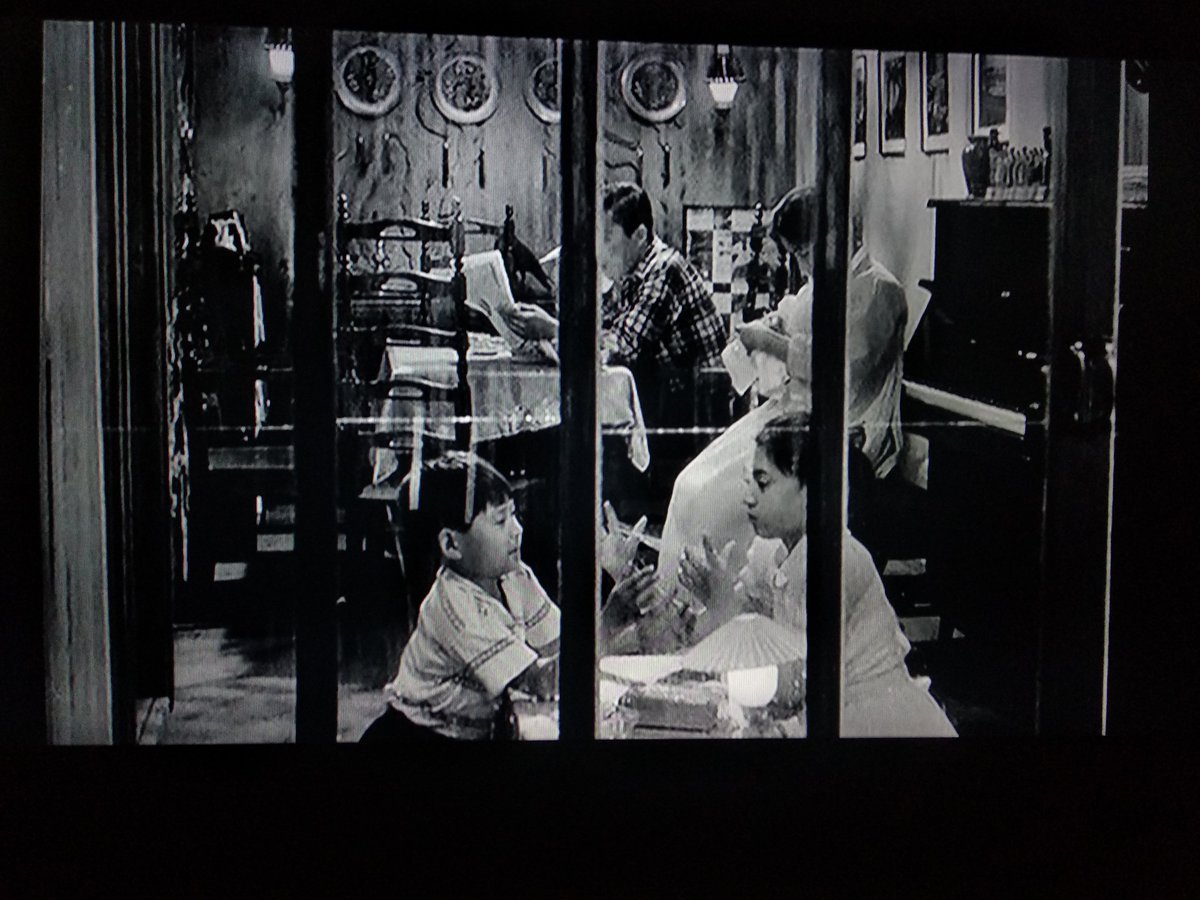
In appearance and character she belongs to an earlier era, the centre of what she calls their “sacred home,” and unlike the brazen young women at the factory where Dong-sik teaches an after-work singing group. Unlike them, she doesn’t smoke, backcomb her hair or wear their tight, fashionable clothes; in the film she’s only shown once outside the home, standing on the street outside. Even when she gives birth, Mrs Kim is confined to the house she’s helped to build. The factory, with its giant whirring looms and reels, suggests what will replace her hand-work, like the new generation of girls who work there. In both cases, the desire for money and upward mobility disrupts the traditional family and home. At the factory, the girls live in dormitories and push each other around by their work lockers. When Cho Kyung-hee (Lee Eun-Shim, who also appeared in Kim Ki Young’s 1959 film Defiance of a Teenager) decides to take private piano lessons, she roams the city in taxis.
The Kim family’s desire for more money, to fund the new house they’ve built, not only means Mrs Kim works day and night, falling asleep over her sewing machine. (“Women always work more” than men, Cho Kyung-hee tells her. There’s possibly intentional irony in this: Kim Ki-young’s own independent filmmaking career was supported for years by his wife Kim Yu-bong’s dental practice.) Dong-sik admits two of the factory girls into their home, one as a pupil and one as a maid. With them whirls in jealousy, temptation and manipulation, none of which Dong-sik anticipates or can handle, especially as he can’t afford to lose his teaching position at the factory.
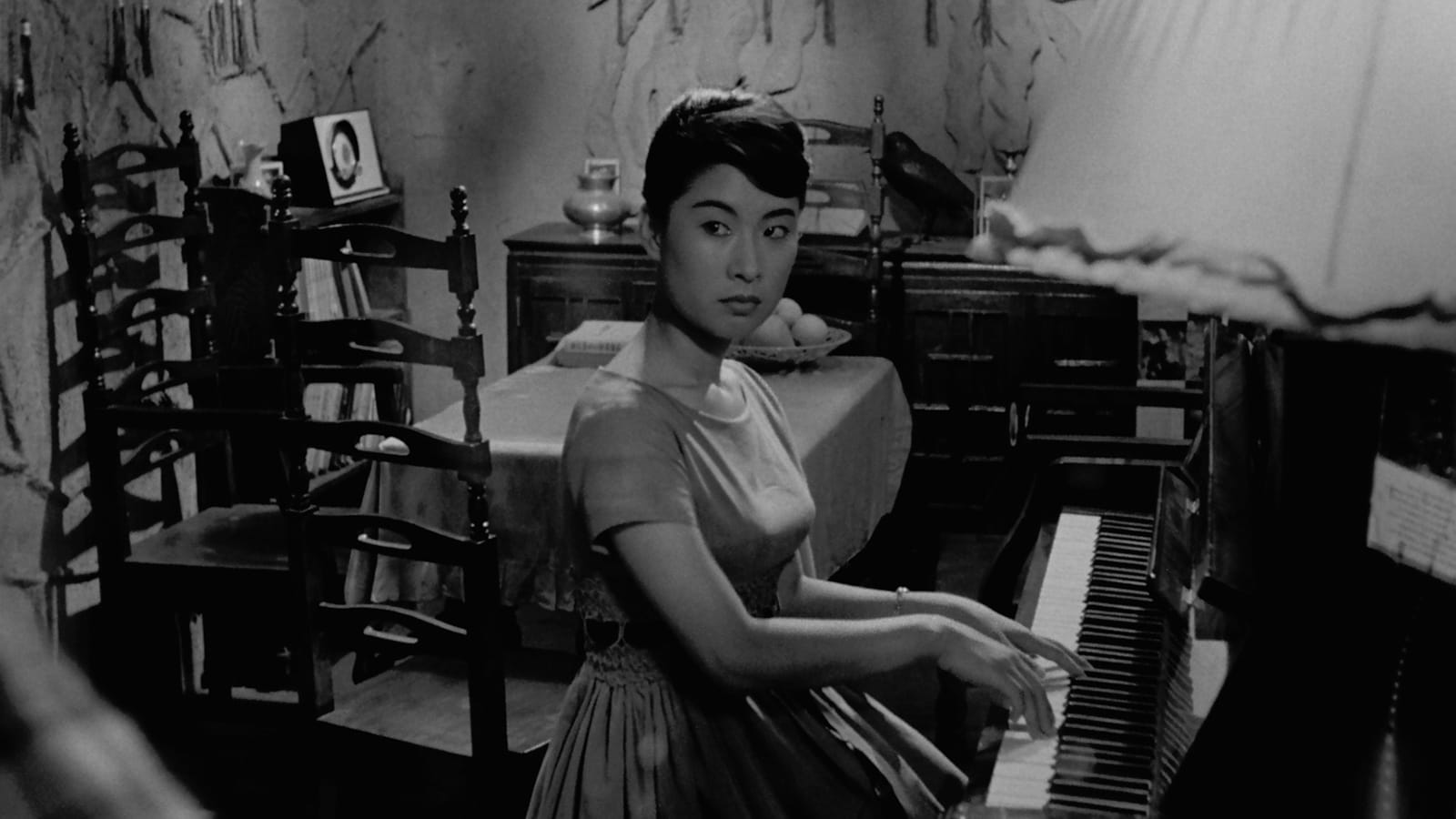
Much has been written of the use of architectural space by Kim Ki-young, particularly the staircase, an emblem of the family’s bourgeois aspiration: it provides access to the maid’s room and to Kim Dong-sik’s music room, where he composes and teaches private students. (“The stairs are as important as the characters in the film,” says Bong Joon ho.) Looming over the stairs is another gargoyle-like Beethoven death mask, like the one that glares down at the factory piano, more evidence of Dong-sik’s hubris as an aspiring artist, as well as a visual reminder of the doom hanging over him. The stairs form centre-stage in the house and the story, the venue for threats, accidents and more than one death—in the tradition of any number of Fritz Lang films, as well as classic Hollywood melodrama, like William Wyler’s 1941 film version of The Little Foxes and psychological thrillers like Hitchcock’s Shadow of a Doubt (1943). Both rats and a staircase are crucial to the psychological horror of Robert Aldrich’s Whatever Happened to Baby Jane? (1962).
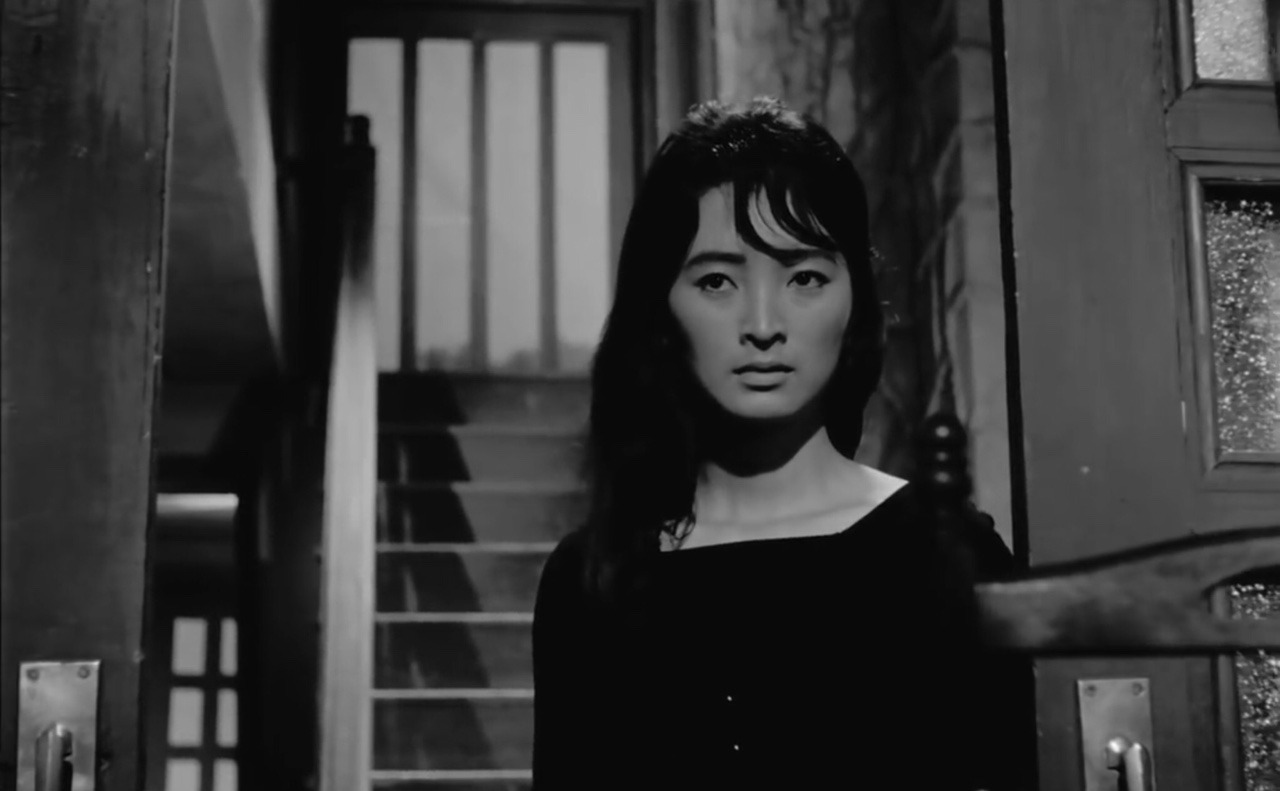
The stairs first appear in the film when the house—set behind the Kim’s smaller, older one—is still being built, an obstacle course of planks and debris, where the boisterous boy of the family, Chang Soon (Ahn Sung-ki of Mandala and The Tower), can torment his sister, Ae-soon. She needs crutches to walk for reasons never specified, and Dong-sik is stern with her about exercising to gain strength. In the new house, everything will be perfect, like post-war South Korea and its shiny trains and factories, free of Japanese colonial rule and the hardships and fear of two recent wars. But the move into the new house means a disorder that pregnant Mrs Kim can’t manage, including rats stalking the kitchen, so she requests a housemaid.
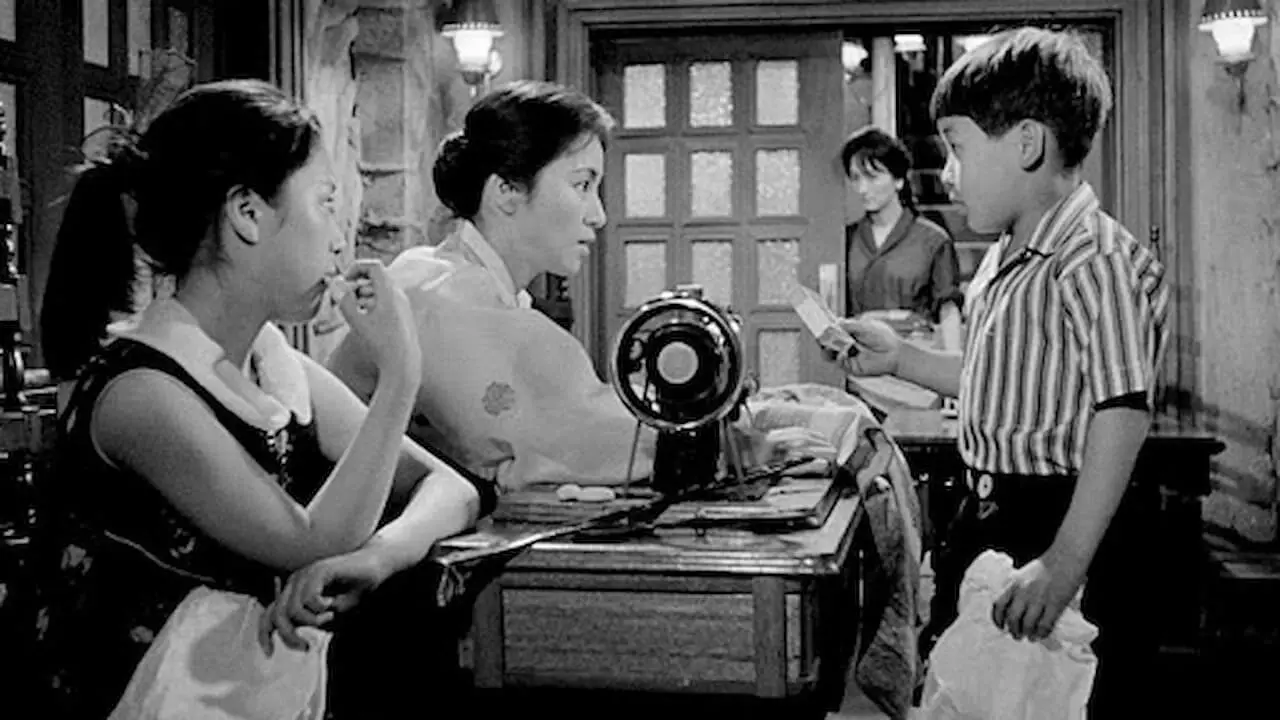
Kyung-hee recommends someone she knows, the waif Myung-sook (Lee Eun-shim), who is “not too bright.” Myung-sook seems to have been skulking around the factory dorm where she works as a cleaner. The actress Lee Eun-shim, an unknown when she was cast, has an expressive, flat-planed face that suggests both the passion and melancholy of actresses of neo-realist Italian cinema, enlivened with spite. What seems at first to be child-like whimsy is an oddness that makes the children rightly suspicious. Within minutes of arriving she’s caught and butchered a rat, her eyes gleaming in triumph.
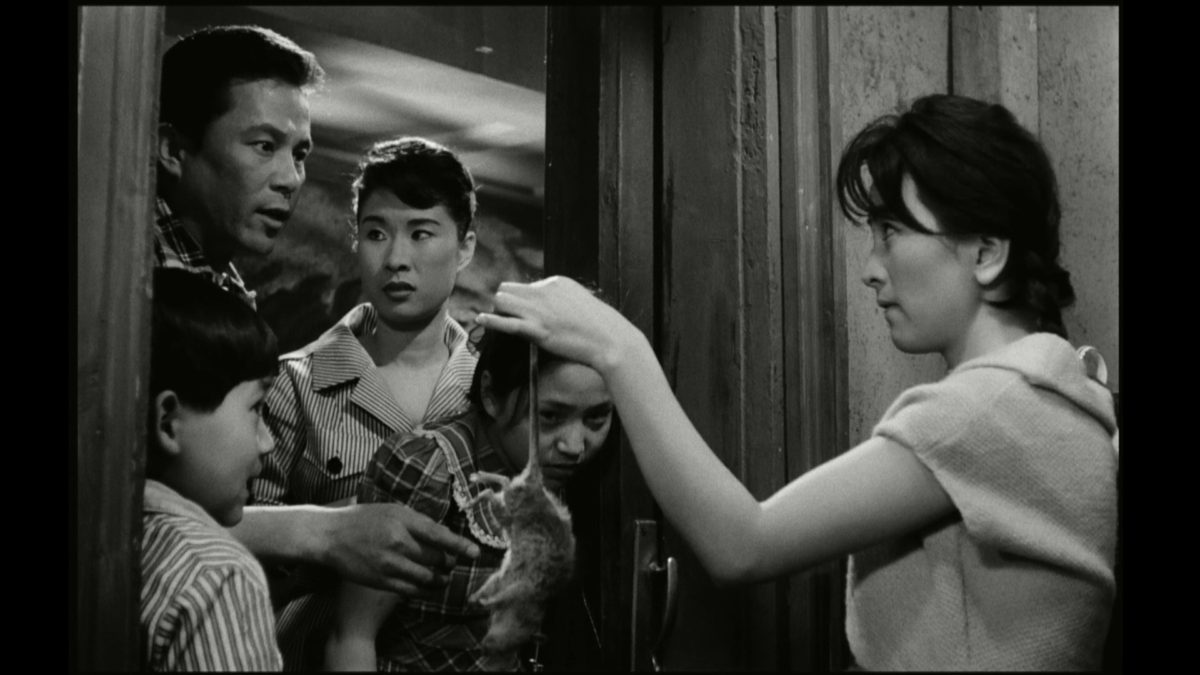
Conniving and covetous, Myung-sook pilfers Dong-sik’s cigarettes and spies on Kyung-hee’s lessons with him from the balcony outside. She is a feral creature like the caged ground squirrel Dong-sik buys for his daughter, tapping at the window, hiding barefoot in the rain.
“You must never touch the piano,” Dong-sik informs her, but he soon learns that Myung-sook respects no boundaries. For all his big talk, he also transgresses, and unlocks the cage. Critical response to the film—at the time and now—often casts Myung-sook as predator and seductor, a demon defiling the “sacred home.” But she is the third in a line of young women from the factory declaring their love/lust for Dong-sik. Kwak Seon-young (played by Ko Seon-ae) leaves him a love letter that he derides as “indecent;” when he reports her, she’s suspended from her job and returns to her hometown to kill herself. Kyung-hee grabs him—at the piano—then rips her own clothes and threatens accusations of rape. Dong-sik seems impervious to these advances.
But when Myung-sook stands at the rain-battered window, her naked back turned to him, he initiates contact. Is this because of her lower status, as a member of his household? Perhaps for all the modernity of his home, habits and workplace, Dong-sik has a profoundly old-fashioned sense of status. The master of the house can have his way with the staff and face no consequences. But, of course, times have changed, and staff are no longer compliant. Myung-sook has aspirations of her own. The film, Se-mi Oh writes in “The Cat’s Cradle: Middle-class Optics of Desire in Kim Ki-young’s The Housemaid”, “connects sexual desire to material desire and to desire for class elevation.”
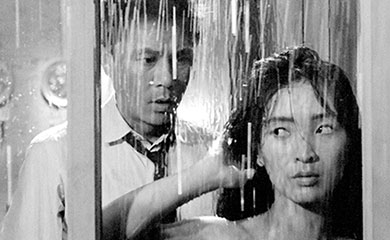
Through his eclectic, prolific and genre-bending career, Kim Ki-young kept returning to this story, re-making his own film twice in Woman of Fire (1971), with Youn Ya-Jung (Minari, In Another Country, the 2010 remake of The Housemaid), and Woman of Fire ’82 (featuring a young Kim Hae-sook of the TV series Start-Up and movies including Assassination, The Throne and The Handmaiden). He also explored adultery and young-woman-as-predator in Insect Women (1972) and Beasts of Prey (1985). The films of his “that saw success,” Kim Ki-young said, “were those about demon-like femme fatales who, for their own reasonings, destroy domestic peace.”
The Housemaid was restored in 2008 by the Korean Film Archive and Martin Scorcese’s World Cinema Project: it’s available on DVD through Criterion, as well as on various streaming services.